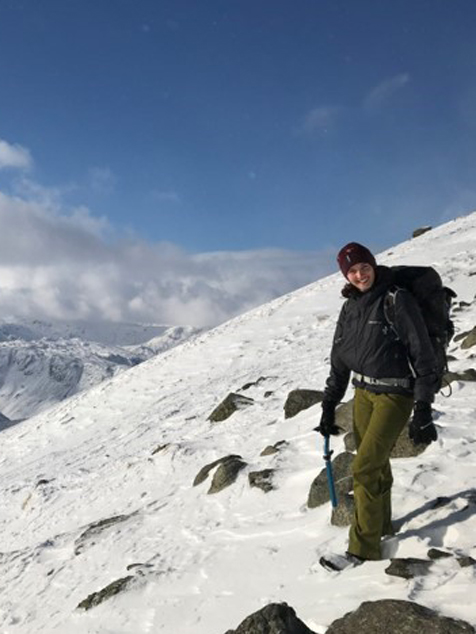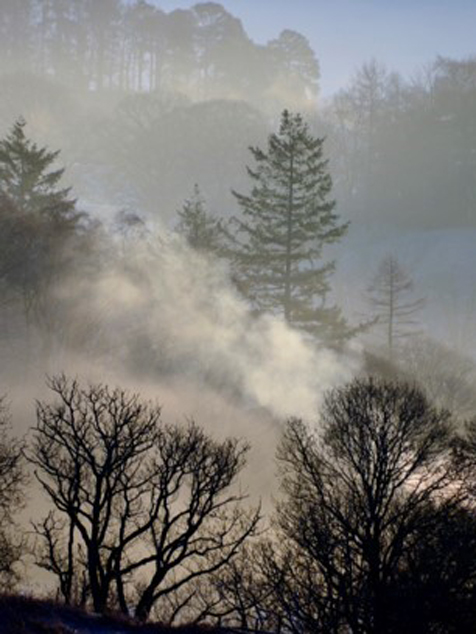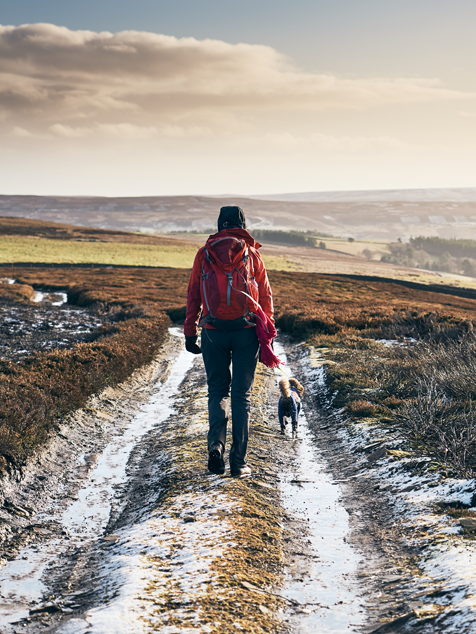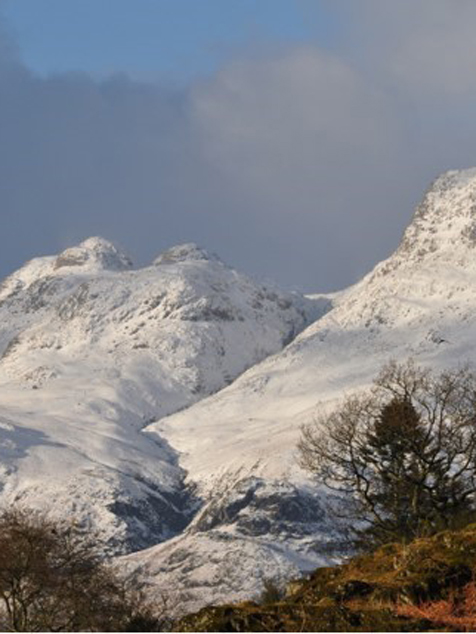Be Adventure Smart in Winter
Winter brings additional challenges for us all, especially when the hills are covered in snow, the weather conditions close in, the air and water temperatures drop significantly, the winds increase the chill factor and our waterways (rivers, lakes, canals) begin to freeze over. Paddling one of our many waterways, exploring the coastline or venturing into the hill and mountains in winter brings with it a truly unique and rewarding experience but remember that days are short and weather conditions can change quickly….so you need to plan for all conditions.
To ‘make your good day better’ in winter you will require additional GEAR, SKILLS & KNOWLEDGE and a greater understanding of the WEATHER, beyond those needed in the summertime.
In winter, whether heading out for a walk with the dog; venturing into the hills to walk and/or climb; or braving the coastal or inland waters for a swim, paddle or sail, make sure you ask yourself 3 questions before you set off:
1. Do I have the right GEAR?
Check out our ‘Essentials Kit List’ to ensure you have what is needed for your chosen winter adventure. It doesn’t need to be the most expensive, high tech kit; you just need to pack the right things to ensure you can enjoy your day whatever the conditions.
On the Land…
What to Wear
- Warm/windproof trousers or leggings
- Thermal leggings/base layer
- Thermal top/base layer
- Fleece/insulating top layer
- Rigid-soled footwear with appropriate socks
- Warm hat and buff
- Gloves or mitts
- Sunglasses – sometimes the sun does shine in winter!
- Waterproof jacket & over-trousers
If you are venturing beyond the lowlands you will also need;
- Goggles – essential for navigation in some conditions whether you are on foot or a bike
- Walking axe – and knowledge of how to use it
- Crampons – check they are suitable for and fit your boots and you have the skills to use them safely
What to Carry
- Rucksack & rucksack liner – an old rubble bag will do. Your stuff will get wet without one!
- Spare insulating layer(s)
- Map & compass and knowledge of how to use them
- Headtorch – check the batteries & carry spares if necessary
- Whistle
- Fully charged mobile phone and powerbank – carry it in an interior jacket pocket close to your body to keep the device both accessible and warm; this will help preserve battery life.
- High energy food and a hot drink – it’s important to stay hydrated even when it’s cold.
- Sunscreen
- First Aid Kit (small)
If you are venturing beyond the lowlands you will also need;
- Walking poles (optional)
- Emergency survival shelter (polythene is OK) and a Group Shelter
On the Water…
What to Wear
- Thick waterproof cag/jacket – Cags are a little like waterproof coats, only they usually have waterproof seals on the neck, trunk and hands to prevent water getting in
- Lifejacket or buoyancy aid – well-fitting and well maintained
- Waterproof trousers
- Drysuit if you are planning on staying on the water.. they are brilliant for all forms of paddlesport and sailing activities.
- A winter wetsuit – if you are going in the water, they tend to be thicker providing additional insulation.
- A spray deck – brilliant for keeping the water out of your kayak.
- Thermal base layer (leggings and top) – Fleece layers are also a great insulator.
- Thick winter wet boots or firm-soled footwear with neoprene socks – will keep your toes from getting cold and cramped.
- Woolly/fleece hat or neoprene skull cap if venturing into the water.
- Pogies and neoprene mitts or gloves. Pogies are essentially pockets for your hands, some people also opt for neoprene mitts or gloves underneath too.
- Sunglasses – sometimes the sun does shine in winter!
If you’ve already got this kit, double-check it for holes and fix any tears or holes before you head out onto or into the water.
What to have waiting for you when you get off or out of the water;
- A warm coat or dry robe. Dryrobes are spacious and can be thrown on just as soon as you get off/out of the water.
- Dry clothes. Take a spare set of clothes just in case you take an unexpected dip!
What to Carry
- Drybag – your stuff will get wet without one!
- A map & compass or GPS – and knowledge of how to use them
- Full charged mobile phone and powerbank – make sure it’s accessible and in a waterproof pouch
- High energy foods and a hot drink – it’s important to stay hydrated even when it’s cold
- Emergency survival shelter (polythene is OK) and a group shelter
- Spare insulating layer(s)
- Headtorch – check the batteries & carry spares if necessary
- Whistle
- Sunscreen
- First Aid Kit (small)
2. Do I know what the WEATHER will be like?
Winter weather is notoriously unpredictable. Take time to understand what the weather has been like over the past few days, what the weather is doing on the day of your adventure and how that affects the ground and environmental conditions.
Heavy rainfall through autumn and winter can change river patterns and levels dramatically so, it’s always worth checking the flow and levels before heading out on the river. Strong winds will affect the sea swell along the coast and shoreline and make conditions on inland lakes tricky.
On land, snow, rain and hail can make ground conditions difficult. Freezing ground conditions are especially treacherous; and may require crampons; make sure they are adjusted for your boot size and you have the knowledge and skills to use them. If you are mountain biking avoid routes with deep snow.
Strong winds can affect your ability to make progress and add to the wind chill factor; this will become more significant the higher you go. Remember that in wet weather, cold air temps and strong winds, you will tire more quickly – you may need to alter your plans, stick to lower levels and/or take a shorter route.
The Met Office has a dedicated mountain weather forecast site, providing mountain forecasts for the main mountain areas. Forecasts are issued twice a day and cover daylight hours. Weather conditions can change rapidly with time and, if you are in the hills/mountains, will also vary with height. Check the forecast for the highest point on your route and for your start and finish time.
Some regions provide current local information about the conditions in the hills and mountains:
Lake District Fell Top Assessors @lakesweather
Snowdon Ground Conditions @snowdonweather
Why is understanding the weather forecast especially important in the hills and mountains?
- Storm-force winds, persistent heavy rain or blizzards can be raging at the top when it is merely cloudy and breezy in the valleys.
- Colder conditions at height and strong winds can give a severe wind chill and lead to hypothermia, especially if waterproofs become soaked through in wet conditions.
- Ice and snow due to colder temperatures at height. Lying snow can last long into spring or summer, especially on sun-shielded north-facing slopes.
- Certain conditions can also give rise to avalanches. Avalanche forecasts for Scotland are provided by the Scottish Avalanche Information Service.
- Low cloud, either from cloud moving across the area or generated by the hills themselves, results in very poor visibility. Cloud cover or heavy snow combined with snow cover on the ground can give whiteout conditions.
If venturing into or onto the water, check the weather conditions for the area you will be going to and continue to check as these conditions will change quickly.
Make sure you plan ahead for your winter adventure;
- Plan for shorter daylight hours, it will get dark quicker if the skies are overcast. Set out in good time, carry a torch, even if you intend to be back long before the dark descends; check your batteries before setting off and carry spares.
- Gather relevant information about where you are planning to go right up to the planned day and then throughout your trip.
- Check the latest weather and ground conditions before you set off – take advice, only attempt a trip if the conditions are within you and your companions’ capabilities.
- If in doubt, alter your plans or go with a qualified guide.
Be flexible – there’s no shame in changing your plans. Choose a different route or turn back if the forecast doesn’t look too clever; if the weather closes in unexpectedly or if the conditions turn out to be more difficult than you’d expected.
3. Am I confident I have the right SKILLS & KNOWLEDGE for the day?
Whether you are new to venturing outdoors in winter or a seasoned pro, wherever you are going and whatever you are doing, consider your SKILLS & KNOWLEDGE and those of your companions. Your plans must take into account the skills and knowledge of the least able/experienced person in your group.
Navigating in winter is a step up on what you already know and do if you venture out in summer conditions. As a result, you will need to be much more precise as there are many more variables to take into account: poor visibility, frozen ground, snow cover, avalanche risk; all of which will require you to have an enhanced set of skills and a greater understanding. Whatever your chosen activity it’s a good idea to improve your skills with some training:
Hill walking/Mountaineering
Canoeing and other paddlesports, including SUP
Mountain biking
Sailing, Windsurfing and Powerboating
Rock climbing
Horse riding
If you are heading for the hills on foot or mountain bike and realise that reaching the summit is going to be a challenge then switch to a lower level that you can all enjoy and achieve comfortably.
- If the weather or ground conditions are beyond your capabilities or equipment, consider your options – it’s ok to choose a more suitable route or to turn back.
- Look for well described, promoted routes suitable for your ability. Check out National Park and AONB websites for walking routes for all abilities.
Be realistic about the amount of time you will be out. With fewer daylight hours and colder temperatures, you need to plan shorter outings which will be less physically demanding and therefore achievable for all in your party.
- Be honest with yourself about you and your companions’ knowledge, fitness and ability.
If you are swimming or paddling, the technical skills required to tackle inland waters can increase dramatically after rainfall, and water levels can rise and fall quickly.
- Be realistic about your skills and those of your group – don’t take a chance.
If you end up in the water either intentionally or unintentionally, remember to ‘Float to Live’. Cold water shock passes in less than 2 minutes, so relax & tilt your head back with your ears under water until you can control your breathing. Use your hands to help you float.
First aid saves lives and knowing what to do in an emergency can make all the difference.
- Download the St. John Ambulance first aid advice app and sign up for first aid training England/ Wales
Let the experts show you the way.
- If you’re doing something new, going somewhere new or exploring new terrains or conditions why not go with a qualified guide/instructor.
What to do in an emergency?
Accidents happen – even those who are well prepared can find themselves in difficulty. Knowing what to do in an emergency is essential, take time to assess the situation and decide what to do:
- Stay calm and stay together.
- Check that no one in your group is in immediate danger, you may need to move away from the danger.
- If anyone is injured, you may need to treat them. Look for signs of life (airway/breathing/circulation) or blood loss. Download the St John Ambulance first aid advice app (No internet required to use the app: all the information is hosted on the app).
- Insulate the casualty from the ground, add extra clothing and if they are unconscious place them in the recovery position.
- Identify where you are on your map and consider your options:
- Moving to safety – What will the conditions be like? How far do you need to go to reach safety? Are you able to carry the casualty? Will the casualty’s injuries be made worse by moving?
- Finding shelter – Don’t use up valuable time and energy unless you are sure about finding shelter. Use your group shelter.
- Staying put – Will your situation be resolved if you stay where you are?
- Seeking help – Remember that even when the emergency services have been called they may take several hours to reach you.
Call 999 or 112 and ask for Police and Mountain Rescue if in the mountains or hills, or Coastguard if on the coast or at sea. Conserve mobile battery life by having all the details to hand before phoning for help.
You will need to give them the following details;
- your location (grid reference if possible)
- name, gender and age of casualty
- nature of injuries or emergency
- number of people in the party
- your mobile phone number
Search and Rescue Teams may send a text message using SARLOC or Phone Find to help find your location. Check who in your party has a mobile phone (and coverage) and evaluate the amount of battery life available in the event of additional calls being necessary. Preserve battery life by closing other apps and keeping your phone in an interior jacket pocket.
If there is no mobile signal at your location, consider whether it might be worth moving to another location to phone from.
The RYA SafeTrx app monitors your boat journeys and can alert emergency contacts and HM Coastguard should you fail to arrive on time.
If all other forms of communication fail, the internationally recognised emergency signals are six blasts on the whistle or six torch flashes repeated every minute.





